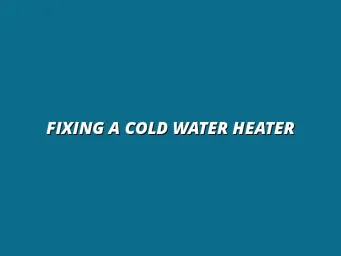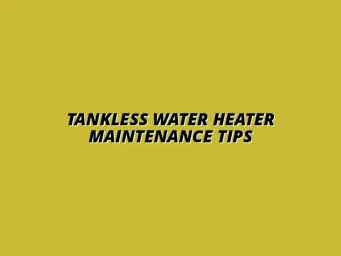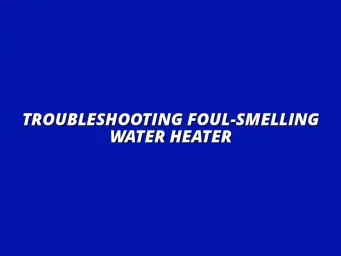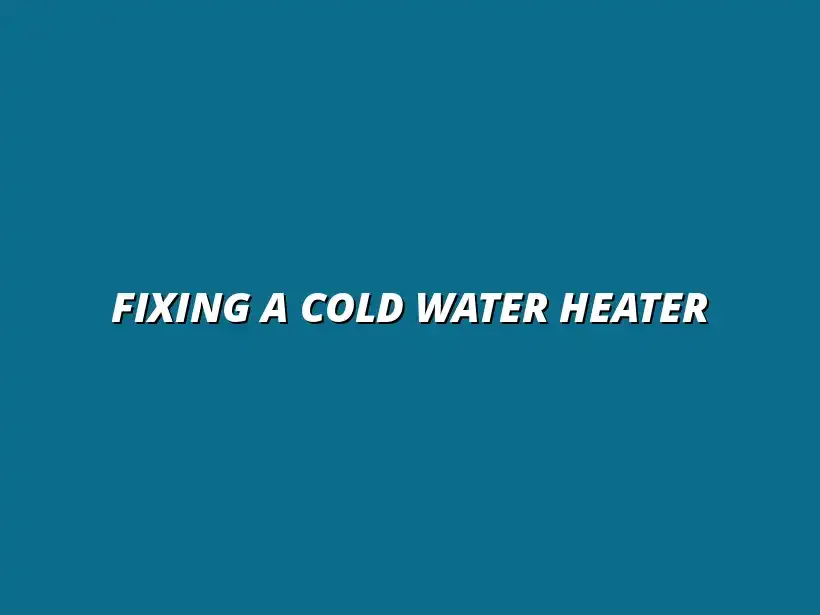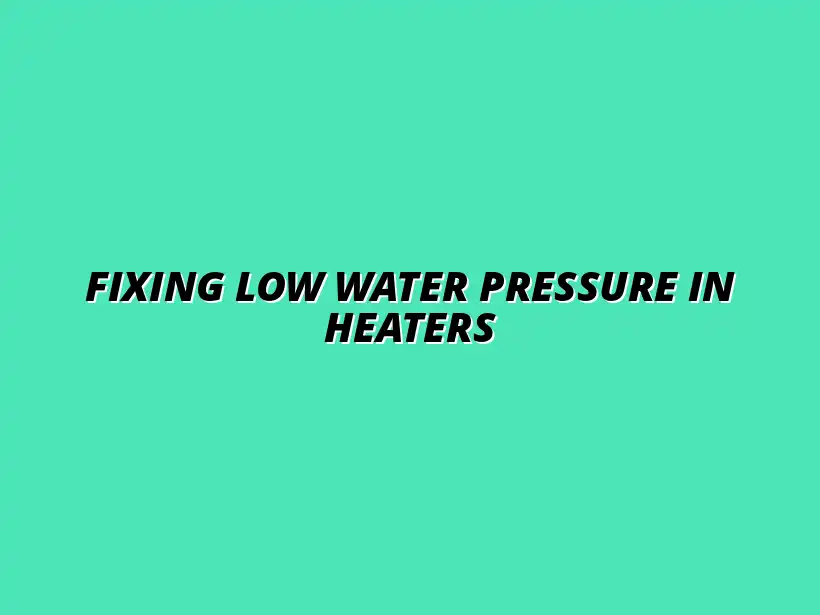
Fixing Low Water Pressure in Heaters
Understanding Water Heater Performance Issues
Water heaters are essential for our daily comfort, providing hot water for showers, dishwashing, and laundry. However, many homeowners face performance issues that can affect their water heater's efficiency. Understanding the symptoms of low water pressure in water heaters is crucial to maintaining a consistent and enjoyable hot water supply.
Recognizing these problems early can help you avoid costly repairs down the road. In this section, we will explore the common symptoms, contributing factors, and troubleshooting steps related to low water pressure in water heaters. For a comprehensive guide on common water heater problems, check out this helpful resource: common water heater issues explained.
Common Symptoms of Low Water Pressure in Water Heaters
Low water pressure can manifest in several noticeable ways that should not be ignored. If you experience any of the following symptoms, it may indicate an issue with your water heater:
- Weak or inconsistent hot water flow
- Longer wait times for hot water to arrive
- Low water pressure at multiple fixtures
These signs indicate that your water heater is not functioning optimally, leading to a frustrating experience when you need hot water the most. It’s essential to take action and diagnose the problem to restore your water heater’s performance. Learning how to fix low water pressure easily can be a great help.
Identifying Signs of Insufficient Water Pressure
When it comes to identifying low water pressure, it's all about being observant. Here are some key indicators to look out for:
- Faucets that produce a weak stream of water
- Showerheads that dribble instead of flow
- Appliances like dishwashers or washing machines not filling quickly
If you notice these signs, it's time to investigate further. Taking prompt action can lead to better water pressure and improve your overall experience. For example, fixing low water pressure in your kitchen sink is often easier than you think; find out how to fix kitchen sink water pressure.
Impacts of Low Water Pressure on Everyday Usage
Low water pressure doesn't just cause inconvenience; it can also affect your daily routines and household functionality. When water pressure is low:
- Showering can become inefficient, leading to wasted time
- Cleaning dishes may require extra effort and time
- Appliances may underperform, resulting in unsatisfactory cleaning results
Addressing these issues not only improves your experience but also enhances the efficiency of your home's water supply system. If you're struggling with slow drains, you might find this guide on how to unclog your bathroom drain easily helpful.
Factors Contributing to Low Water Pressure in Water Heaters
Several factors can lead to low water pressure in your water heater, both mechanical and external. Understanding these causes can help you pinpoint the problem and find effective solutions.
Whether it’s a faulty component or external supply issues, identifying the root cause is the first step toward resolving low water pressure.
Mechanical Causes Affecting Water Heater Efficiency
Mechanical issues are often the primary culprits behind low water pressure in water heaters. Here are some common problems you might encounter:
- Faulty pressure relief valve
- Clogged pipes
- Sediment buildup in the tank
Each of these mechanical factors can significantly impact the overall efficiency of your water heater. Addressing these issues promptly can lead to improved water pressure and performance. Regular maintenance is key to keeping your water heater running smoothly; learn more about how to maintain your water heater efficiently.
Faulty Pressure Relief Valve: A Key Issue
The pressure relief valve is crucial for regulating the water pressure inside the heater. If this valve malfunctions, it can result in low water pressure. Regularly checking the valve and replacing it when necessary can help maintain optimal performance.
Failure to address a faulty valve may lead to more serious issues, so it's important to keep an eye on this component!
Clogged Pipes and Sediment Buildup in Water Heaters
Over time, pipes can become clogged with minerals and sediment, which restricts water flow. This buildup can occur for various reasons, including hard water and lack of maintenance.
To prevent this, flushing your water heater periodically is recommended. Not only does this enhance water flow, but it also extends the life of your water heater. For a step-by-step guide, see how to flush your water heater easily.
External Factors Influencing Water Pressure
In addition to mechanical issues, several external factors can affect water pressure in your home. Understanding these influences is key to maintaining optimal performance.
By addressing external factors, you can effectively manage and improve your water heater's performance.
Municipal Water Supply Variability
Water pressure can fluctuate based on the municipal supply. If the local water supply experiences changes, this can impact your home's water pressure. Keeping an open line of communication with your water supplier can help you stay informed about any changes.
Moreover, understanding how municipal changes affect your system can guide you in managing your water heater more effectively.
Temperature and Its Effects on Pressure Levels
Temperature can also play a role in water pressure. As water heats up, it expands, potentially causing pressure changes within the system. If the temperature is too high, it may lead to pressure issues.
Regularly monitoring your water heater's temperature settings can help ensure that your system operates efficiently and steadily.
Repair Strategies for Resolving Low Water Pressure in Water Heaters
When dealing with low water pressure in your water heater, it’s essential to take a strategic approach. By pinpointing the root of the problem, you can apply effective repair solutions. This not only enhances the performance of your water heater but also ensures a steady supply of hot water for your home. If you need professional help, consider contacting a plumber in Billesley, Birmingham for assistance.
In this section, we will explore various repair strategies that can help you tackle common mechanical issues as well as maintain your plumbing system effectively. Let’s dive into the practical steps you can take to resolve low water pressure and improve your overall water heater performance!
Addressing Common Mechanical Issues
Low water pressure can often stem from mechanical problems within your water heater. Identifying and addressing these issues early on can save you time, money, and unnecessary stress. Here are some common solutions you can implement:
- Adjusting or Replacing the Pressure Relief Valve: If the pressure relief valve is malfunctioning, it can severely impact water pressure. Adjusting it may resolve minor issues, but a replacement might be necessary for significant problems.
- Flushing the Water Heater: Sediment buildup can restrict water flow. Flushing your water heater regularly helps remove these obstructions, allowing for better performance.
Implementing these strategies can lead to noticeable improvements in your water pressure. Remember, regular checks on your water heater’s components can prevent more significant issues from developing down the line!
Adjusting or Replacing the Pressure Relief Valve
The pressure relief valve is a crucial component that regulates water pressure inside your heater. If you notice signs of leaks or inconsistent pressure, it might be time to either adjust or replace this valve. Adjusting the valve can often fix minor problems, but replacement may be the best solution for persistent issues.
To replace the valve, follow these general steps:
- Turn off the power supply and water to the heater.
- Locate the pressure relief valve and detach it carefully.
- Install the new valve securely and reconnect the water supply.
- Turn the water and power back on, then test for proper operation.
By ensuring your pressure relief valve is functioning correctly, you can maintain optimal water pressure in your system!
Flushing the Water Heater to Remove Sediment
Flushing your water heater is a simple yet effective method to combat sediment buildup that can hinder water flow. Regular maintenance, including flushing, prolongs the life of your heater and improves performance. Here’s how to perform a flush:
- Turn off the heater and allow it to cool.
- Connect a garden hose to the drain valve at the bottom of the tank.
- Open the valve and let the water drain into a bucket or outside.
- Once drained, briefly turn on the cold water supply to stir up any remaining sediment.
- Close the drain valve, remove the hose, and refill the heater.
Flushing your water heater annually can significantly reduce sediment buildup and improve water pressure, ensuring you have hot water when you need it!
Pipe Maintenance and Upgrades
In addition to mechanical issues, pipe conditions can directly affect water pressure. Regular maintenance of your plumbing system is essential for consistent water flow. Here are some strategies to keep your pipes in top shape:
- Cleaning Clogged Pipes: If you notice reduced water pressure, it could be due to clogs. Using a plumber’s snake or chemical drain cleaner can help clear blockages.
- Considering Pipe Replacement: In older homes, worn-out pipes may need replacement. New pipes can drastically improve water flow and pressure.
Staying proactive with your pipe maintenance can prevent more severe pressure issues in the future. Make it a habit to inspect your plumbing regularly and address problems as they arise!
Cleaning Clogged Pipes to Enhance Flow
Blocked pipes are one of the most common causes of low water pressure. Over time, debris, grease, and mineral deposits can accumulate and restrict the flow of water. Regularly cleaning your pipes can enhance their efficiency and restore proper pressure levels.
Here are some methods you can use to clean your pipes:
- Use a plumbing snake to remove stubborn clogs.
- Apply a mixture of baking soda and vinegar to dissolve buildup.
- Flush pipes with hot water to clear minor blockages.
By keeping your pipes clean, you can maintain consistent water pressure and avoid unnecessary repairs!
Considering Pipe Replacement for Long-term Solutions
Sometimes, cleaning isn’t enough, especially if your pipes are old or corroded. In such cases, replacing the pipes may be the most effective long-term solution. New pipes made from modern materials can significantly improve water flow and pressure.
When considering replacement, think about:
- The material of the new pipes (PVC, copper, or PEX).
- The overall plumbing layout of your home.
- Consulting with a professional plumber to ensure proper installation.
Investing in new pipes can lead to lasting improvements in your water heater’s performance!
